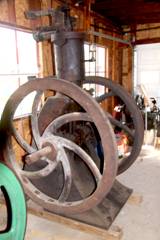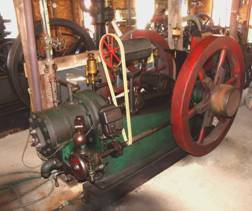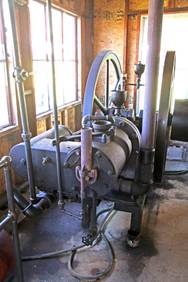BACKUS
This engine is an example of an inverted Backus manufactured by the Backus Water Motor Company of Newark, New Jersey. It is hot tube ignition and features a separate pulley on its crankshaft for driving its load. Rated power output is about 1 hp.

CONNELLY
This engine was built in New York City about 1890 and originally
featured a second cylinder for compound expansion of the power impulse.
Old literature shows it adapted to running small trolley cars. It
was found in an oil field machine shop near Karns City, Pennsylvania, where it
provided power to the machine tools.
It has been modified to run as a four-cycle engine and the second
cylinder has been lost to time.
Records show that a similar engine was made in New Castle, Pennsylvania.
It came to the museum in the early 1970s.
We are unsure of where this one was built.

MODEL 2 KLEIN
The Model 2 was an early design of John Klein and built by National
Transit of Oil City, Pennsylvania, about 1898.
As with all early Transit engines, it is extremely heavy and well
built for its 10 hp. An
unusual feature is the belt driven mechanical oiler.
It pumped crude oil at National Transitís Tiona, Pennsylvania, station and
delivered it to the refinery in Warren, Pennsylvania.
It was brought to the museum in 1968 and was one of the first
engines hauled on the museum's 1946 Reo truck.

REID
This 12 hp Reid, built in Oil City, Pennsylvania, was installed in 1896 and history
attests that Joseph Reid actually inspected the initial operation
of the engine. There, it
pumped crude oil until removed and brought to the museum in 1968.
It was located in the area north of Marienville, Pennsylvania, and still
operating when removed. The
lease still produces but now with a multi-cylinder power unit.
This early engine has flywheels without counterweights and round
weights on the governor. It
has run here for over 40 years!